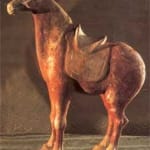Tang Sculpture of a Horse, 618 CE - 907 CE
Terracotta
height 41.3 cm
height 16 1/4 in
height 16 1/4 in
PF.6172
The great influence of the horse throughout the history of China cannot be underestimated. In fact, the ancient expansion of the Chinese Empire was due in large part to the...
The great influence of the horse throughout the history of China cannot be underestimated. In fact, the ancient expansion of the Chinese Empire was due in large part to the horse. The rapid mobility of horse allowed for quick communication between far away provinces. Likewise, the military role of horses aided in the conquest and submission of distant lands. The need to import stronger, faster steeds from Central Asia (as opposed to the local Mongol pony) led to the creation of the Silk Road. The importance of the horse in the history and culture of China can be viewed, in part, through the artistic legacy of this great civilization. In sculpture, painting, and literature, horses were glorified and revered. Horses were believed to be related to mythological dragons, reflecting their sacred status within society. During the Tang Dynasty, the adoration of the horse can be seen through their burial art. Horse models excavated from mausoleums of the period are among the most splendid and easily recognizable works of Chinese art. This type of horse is known as “Fongxiang,” after the area near the city of X’ian, the modern name for the ancient Tang capital Chang’an. Fongxiang horses are primarily painted in subdued hues of red, white, and occasionally yellow. Such horses are also distinctive for their typically strong necks and relatively small aquiline heads. Also, their bodies are invariably well rounded, especially their haunches. This Fongxiang horse has an elegant, multicolor coat. The majority of his body is painted a brilliant crimson while portions of his neck and hind are white, decorated with a spotted pattern that almost appear to be flowers blossoming on the coat of this horse. When gazing into the eyes of this delightful sculpture, we become aware of the reverence the Chinese held for this majestic creature.



